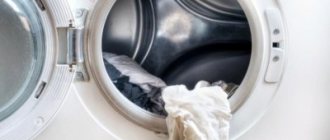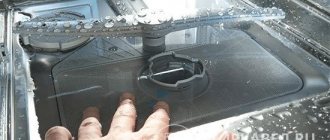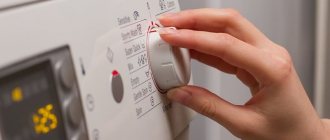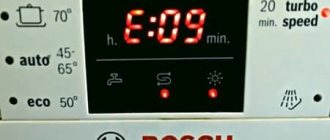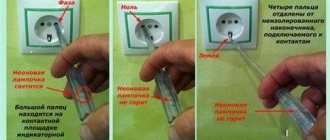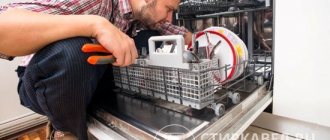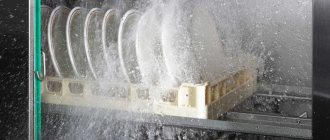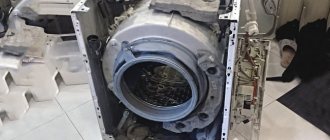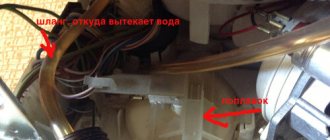Operating a Bosch dishwasher may result in malfunctions. The machine’s self-diagnosis system displays an error code on the display so the user can find the cause of the breakdown.
What are the most common breakdowns in a Bosch dishwasher? Is it possible to do the repairs yourself? You will find answers to questions in the article.
Bosch PMM error codes are collected and described in detail in a separate article.
Possible equipment diseases
Some users who have absolutely no understanding of the complexities of household appliances call service centers for every little thing. But many problems can be solved on your own:
- water does not enter the unit;
- water does not drain;
- The product freezes when turned on.
In the above cases, you can try to revive the equipment yourself. First, check whether the water supply tap is open, then check whether the door is closed tightly, inspect the outlet, maybe the reason is its malfunction. Water may not drain due to clogged filters or connection pipes in the drainage system. If everything is in order there, you need a wizard to diagnose all nodes.
Heating function
When washing dishes with cold water, the quality of cleaning noticeably deteriorates. The cause may be an incorrect location of the drain hose or a broken heating element. If the hose does not have two smooth bends at the base of the machine and at the entrance to the siphon, the water is partially drained into the sewer. The mixture of running and dirty water is noticeably colder than that required for high-quality dishwashing. Therefore, when using the dishwasher for the first time and removing cold and unclean dishes from it, it is first recommended to check the location of the drain hose.
If the hose is in order, there are 3 scenarios:
- replacing the heating element;
- checking the functionality of the thermostat;
- control system repair.
Aquastop worked
Does error code E15 appear on the display? This code signals that there is a leak somewhere, so the water intake is stopped - a typical “disease” of dishwashers of this brand. The problem can be solved quite simply: disconnect from the network, then carefully tilt the unit body to drain the water from the pan, and the sensor float will return to its original position.
If error code E15 occurs, carefully move the car in different directions - this is often enough for the stuck float to return to its original state and the code disappears from the display.
Error E15
The second common problem is the gaskets at the junction of the inlet hose with the machine and water supply system. If they are installed incorrectly, water will leak out, so when connecting the machine, you must carefully read the instructions.
Fill valve failure - from RUB 1,900*
The inlet valve is responsible for filling water into the dishwasher.
Normally, the electromagnetic coil opens the membrane flap based on a signal from the control board, and water is drawn into the machine. When the coil burns out or the valve membrane is damaged, the dishwasher stops working as it should. In rare cases, the valve body itself cracks: this can happen if the PMM was in an unheated room. SIGNS
If the valve's solenoid coil fails, it does not open and the Bosch dishwasher does not draw water. When the valve membrane is damaged, the situation is the opposite - the dishwasher constantly fills with water, even when turned off, and the leakage protection sensor may be triggered. On Bosch models with a screen, valve failure may be accompanied by the following error codes: E3 (F3), E5 (F5), E14 (F14), E16 (F16), E17 (F17) or E18 (F18).
HOW TO FIX
A faulty fill valve must be replaced with a new one.
*Prices are only for the work of the master, a new fill valve is paid separately.
The machine does not turn on
Suspicion immediately falls on the mechanism of the power button: although it is designed for 1 million activations, there are different cases due to weak contacts. If the home handyman knows how to use a multimeter, then this is not a problem: ring the contact groups to make sure they are working properly.
It is worth checking the serviceability of the power cable and socket - sometimes repairing a Bosch machine with your own hands begins with these activities. If everything is fine, then you need to test the control module. This cannot be done at home - you need a professional technician from a service center who will dismantle the required part and test it in the laboratory.
Start button on control panel
The drain filter is clogged
Symptoms: the program stops when you try to drain the water
The control board can block the continuation of washing even if there are any problems with the drainage, and rightly so: it will still not be possible to wash the dishes properly. One of the most common reasons is a clogged drain filter: water with detergent residue will not quickly leave the chamber, will remain on the dishes and turn into unpleasant stains after drying. We advise you to make it a rule to clean the drain filter after each wash - it gets clogged quickly.
Water does not flow in or drain out
We have discussed one reason in detail - this concerns the Aquastop system, the second may be due to a clogged filter. Cleaning it can be done quite easily without special technical knowledge - unscrew the fill hose, carefully pull out the mesh filter and rinse it under running water.
The filling valve located immediately behind the filter may also be faulty, but it is not repaired, but simply replaced with a new device. Details of the repair can be seen in videos, of which there are many on the Internet.
Sometimes this happens: water enters the unit, but the machine freezes in the rinse mode, in this case there are only three reasons:
- The drain filter is clogged - it can be easily solved on your own.
- The water drain hose is kinked.
- The pump requires repair or replacement.
In the first case, everything is simple: at the bottom of the working chamber (tank) there is a coarse mesh filter, and a fine filter element is located nearby. It will take you no more than 10 minutes to remove and clean.
You can find out the condition of the hose by looking behind the car and visually determining its condition; if everything is normal, then the problem is not in it. To get to the pump, you will have to disassemble almost the entire car, since it is located at the very bottom; in addition, the car is turned upside down. Typical pump malfunctions are clogging with foreign objects, and the plastic impeller very often breaks or rotates on the axis due to blocking by a foreign object.
Important! Replacing the pump is a fairly complex dishwasher repair, so realistically assess your capabilities before you start disassembling the equipment.
Before replacing the drain pump, it is better to ring the voltage supply wires to ensure their integrity. If you find a defect or break, replace it, but observe the cross-section size.
Drain pump
Spontaneous shutdown
The dishwasher may turn off for the following reasons:
- Wrong washing mode set.
- There is no power supply. You need to check the switchboard, perhaps the fuse has blown or the circuit breaker has switched off.
- The fuse in the plug has blown. It is necessary to replace it and check the entire safety device.
- The main pump is clogged. This problem is difficult to debug with your own hands, but you can check the exhaust port. You need to lift the filter and inspect for blockages.
- Problems with the thermostat.
- The heating element has failed.
- The programmer is broken.
- Water does not flow into the working chamber. This may be due to the tap being closed.
The float switch often breaks
. It is a mechanism in the form of a plastic float located in the floor of the machine. When the chamber is full, it floats up. This switch can block the operation of the dishwasher if its valves are faulty.
The inlet port may have failed
located on the bottom of the device. It may become clogged and block the passage of water.
The pressure switch may break
. It needs to be disconnected from the terminals and blown into the pipe to which the plastic tube is adjacent.
Failures in the electromagnetic control coil are also common. The breakdown is very serious and will require the intervention of specialists.
the sprayer may fail
A burnt out motor or problems with a pump require calling in a professional.
The electric heating element may burn out during the drying phase.
or the fan will malfunction and the machine will turn off spontaneously.
No quality dishwashing
Quite often, users complain about poor quality dishwashing. The reason often lies in the fact that the operating mode was set incorrectly, but sometimes the machine is at fault due to clogged injectors or other annoying malfunctions.
The entire calculation of washing quality is based on the rocker nozzles. The flow speed sometimes exceeds 150 km/h; due to the strong pressure, these main elements of the working area rotate and knock off all the dirt and food debris from the dishes with elastic jets.
The main reasons for low pressure are as follows:
- clogging of the holes on the rocker arms;
- the coarse or fine filter is clogged - because of this, the required amount of water does not return to the tank to ensure normal pressure;
- temporary wear of the circulation pump impeller, so it cannot produce normal pressure;
- low engine speeds due to bearing wear and runout.
Cleaning the nozzles on the rocker arms is not difficult for any user; physical force is not required; on the contrary, it is better not to use it when removing a fragile product. Rinse the holes with running water; if any foreign particles remain, remove carefully with a toothpick.
Note to the owner! The more food debris you remove from the plates before placing them in the baskets, the less often the filters and nozzle holes will become clogged, without requiring urgent repairs.
Bosch dishwasher repair
Bosch dishwashers have been produced by the German company of the same name Robert Bosch GmbH since 1967 BSH Bosch und Siemens Hausgeraete GmbH. The history of the Bosch company begins in 1886. The first dishwasher was released in 1965. Production is concentrated at factories in Germany and Poland.
Bosch
dishwashers has led to the creation of a number of innovations, embodied in several generations of machines. The company's strategy is longevity and reliability combined with comfort and environmental friendliness. According to Bosch standards, after a product is discontinued, parts and consumables for it continue to be produced for at least 10 years. The manufacturer has also developed a new ActiveWater circulation system, where water has never been used so efficiently, 10 liters of water per dishwashing cycle.
Even a machine from a reputable manufacturer can malfunction or break down!
Quick online diagnostics of dishwasher faults (Simply select a problem from the list and find out the approximate breakdown)
Bosch dishwashers have the function of displaying an error code when certain malfunctions and malfunctions occur. Quite often, understanding what the error code means , you are able or breakdown yourself
For your convenience, a list of error codes for Bosch dishwashers is provided with an explanation of each specific code . The table also includes a description of the error, the reasons for its occurrence and possible solutions.
Decoding error codes for Bosch dishwashers
| Error code | Description of the error | Causes and elimination |
| Errors on machines without a display; in the normal operating mode of the device, when there is some problem, only the “Tap” indicator blinks or lights up, and to clarify the error, you need to go to diagnostic mode. | ||
| All indicators are flashing. | Software error. | There is a failure in the machine’s system software or the control module is faulty. Restarting the machine may help. |
| E01 Flashing | The main control unit of the machine is faulty. | 1. Check the voltage in the electrical network. 2. Check the wires leading to the electronic boards for breaks or short circuits. 3. Electronics malfunction. |
| E1 F1 | The heating does not turn on due to a sensor or electronics error. | Water heating does not start because problems have been detected with the signals from one of the sensors or the heater. 1. One of the sensors is faulty - a temperature sensor (thermistor) or a water level sensor (pressostat). 2. Too much water has been poured into the tank (for example, due to a faulty level sensor) 3. The temperature sensor (thermostat) is not working correctly. 4. Open circuit in the heating element control circuit. 5. Short circuit in the heating element circuit, leakage to the housing. 6. The heater burned out. 7. Problems with the control controller. |
| E02 Flashing | No heating due to electronics problems. | There is a malfunction with the heating element relay that controls the operation of the heater. 1. Broken wire or loose contact in the heating element circuit. 2. The heating element relay on the electronic board has failed. |
| E2 F2 | There were problems heating the water due to a faulty NTC temperature sensor. | As a result, the temperature of the water in the tank will differ from the set one, which will affect the quality of the wash. 1. Make sure that the wiring between the sensor or heating element and the control controller is in order, that all contacts and connectors are securely fastened 2. The absence of a signal from the sensor may indicate its malfunction. 3. Problems in the control controller. |
| E03 Flashing | Additional drying does not work due to an electronic failure. | There is a problem with the additional heating element relay that controls the operation of the heater. 1. Broken wire or loose contact in the heating element circuit. 2. The heating element relay on the electronic board has failed. |
| E3 F3 | Problems with water collection, the tank does not fill in the required period of time. | Depending on the model, the dishwasher will either wait until the tank is completely filled with water (this was the case in early models), or the washing will stop after a minute (a more reasonable solution in modern models) 1. Water does not enter the machine, the water supply tap is turned off, low pressure in the water supply , defective or clogged hose, inlet valve clogged. 2. The door is not closed tightly and the electronics are blocking the start of the washing program 3. The inlet solenoid valve is broken. 4. The water level sensor (pressure switch) is faulty. 5. A break in the wiring or loose contacts in the circuits from the control controller to the inlet valve or pressure switch. 6. Management controller failure. |
| E04 Flashing | The water does not heat up due to an electronic malfunction. | There is a malfunction with the heating element relay that controls the operation of the heater. 1. Broken wire or loose contact in the heating element circuit. 2. The heating element relay on the electronic board has failed. |
| E4 F4 | The sprinkler does not work effectively enough. | A problem has been detected with the flow sensor (switch), it is in the wrong position, but the error can be caused by other reasons. 1. Dishes in the chamber are blocking the rotation of the spray arm. 2. Open circuit in the flow sensor circuit. 3. The flow sensor is broken or clogged. 4. Something happened to the motor that changes the position of the sensor. 5. Problems with the control controller. |
| E05 Flashing | Control module failure. | 1. Check the voltage in the electrical network. 2. Check the wires leading to the electronic boards for breaks or short circuits. 3. Electronics malfunction. |
| E5 F5 | There is too much water in the machine, it is not draining or a leak has been detected. | A pressure sensor or float indicates that the machine is overfilled: usually the cause is a blockage or malfunction of the water supply path. 1. Open circuit in the pressure switch circuit. 2. The pressure switch is faulty. 3. The fill valve is faulty, causing water to constantly flow into the machine. 4. Electronics failure. |
| E06 Flashing | There is no signal to close the door. | As a result, the electronics block the start of washing, possible reasons. 1. Lost connection between the door sensor control triac and the control controller. 2. Something broke in the door lock. 3. The door closing sensor is faulty. 4. Problems in the control controller. |
| E6 F6 | Malfunction of the aquasensor, which monitors water quality (hardness, contamination, turbidity) during rinsing. | Cleaning continues based on the assumption of heavy soiling. 1. Clean the dishwasher compartment. 2. Open circuit in the sensor circuit. 3. The sensor itself is faulty. 4. Problems with the control controller. |
| E07 Flashing | Drying fan malfunction. | 1. Open circuit in the fan control circuit. 2. The fan sensor is faulty. 3. Something has broken in the fan itself. 4. Problems in the control controller. |
| E7 F7 | The water does not drain due to problems with the drain hole. | The drain may be blocked by dishes or clogged. |
| E08 E8 F8 Flashing | Heating does not work due to low water level in the tank. | The electronics do not allow heating because the circulation pump has detected that there is too little water in its cochlea. 1. Problems with water intake, See error “E3” 2. Self-draining of water due to leaks or incorrectly installed drain is also possible. |
| E09 E9 F9 Flashing | Open circuit in the heating element (heating element). | The heating element circuit is open, no signal is received from the heater. 1. Broken wire or loose contact in the heating element circuit. 2. The heating element has burned out. 3. The relay on the electronic board that controls the operation of the heating element has failed. |
| E10 F10 Flashing | The dryer does not turn on due to a malfunction of the heating element or fan. | There is a problem with the additional heating element relay that controls the operation of the heater. 1. Broken wire or loose contact in the heating element circuit. 2. The heating element relay on the electronic board has failed. 1. Open circuit in the fan control circuit. 2. The fan sensor is faulty. 3. Something has broken in the fan itself. 4. Problems in the control controller. |
| E11 F11 Flashing | The temperature sensor (thermistor) is faulty. | There is no signal from the sensor at all, or it shows incorrect data. 1. Irregularities in the wiring of the sensor circuit. 2. The thermistor is faulty. 3. Failure in the control board. |
| E12 F12 Flashing | The machine does not dry well due to deposits on the heating element. | A too thick layer of limescale (scale) has accumulated on the heater, making it difficult to dry dishes. |
| E13 F13 Flashing | The water entering the machine is too hot. | The error occurs when the machine is connected to hot water and water with a temperature above 75 C is filled in. 1. The temperature sensor is faulty. See the description of error “E11” 2. If you are unable to control the temperature of the water poured into the machine, you can suggest a radical solution to connect it to cold water, especially since this method has many advantages. |
| E14 F14 Lights up | The water flow sensor (reed switch) is faulty. | If there is no signal from the water fill sensor, while the circulation pump is working normally, the electronics blocks the wash, since there is no way to control the process of filling the tank with water. Standard actions for problems with the sensor: check the wiring and contacts, the sensor itself and the control controller. |
| E15 F15 Flashing | Water leakage from the tank, overflow, leak. | A signal was received from the float of the Aqua-Stop leak control system, which indicates the appearance of water in the sump. 1. Water leaks into the pan, inspect the housing, hoses and their connections. 2. The drain pump is leaking. 3. The water leakage control sensor is faulty or there is a short circuit in its circuit. 4. The error may appear after replacing the electronic control module; in this case, restarting the machine helps. |
| E16 F16 Flashing | One of the valves or sensors is leaking. | A leak is detected either through the fill valve or through the flow sensor (water meter), this can lead to spontaneous water intake. 1. It is necessary to carefully inspect all sensors and valves. 2. The water level sensor (pressure switch) may also fail. 3. The reason may be too much foam formation in the tank. |
| E17 F17 Flashing | Too much water pressure or overflow. | The fill valve is difficult to close due to too high incoming water pressure. As a result, too much water may fill into the tank. 1. High pressure in the water supply. 2. Fill valve is faulty. 3. The level sensor is broken. |
| E18 F18 Lights up | There is too little water in the tank. | The washing does not stop, although its quality is unlikely to be good. Most likely there is a problem with the fill valve, but there could be other reasons. See description of errors "E3" and "E14" |
| E19 F19 | Internal error. | |
| E20 F20 Flashing | A breakdown of the circulation pump that supplies water for pressure washing. | The control module has detected abnormal parameters in the electrical or electronic circuit of the pump motor. 1. Open circuit in the pump motor circuit. 2. Foreign objects have gotten into the pump blades and are blocking them. 3. The tachogenerator is faulty. 4. The motor capacitor has failed. 5. The pump is faulty and requires diagnostics. |
| E21 F21 Flashing | The circulation pump is blocked. | The control module has detected abnormal parameters in the electrical or electronic circuit of the pump motor. 1. Open circuit in the pump motor circuit. 2. Foreign objects have gotten into the pump blades and are blocking them. 3. The tachogenerator is faulty. 4. The motor capacitor has failed. 5. The pump is faulty and requires diagnostics. In addition, the pump may not work due to low water pressure. Depending on the model, the dishwasher will either wait until the tank is completely filled with water (this was the case in early models), or the washing will stop after a minute (a more reasonable solution in modern models) 1. Water does not enter the machine, the water supply tap is turned off, low pressure in the water supply , defective or clogged hose, inlet valve clogged. 2. The door is not closed tightly and the electronics are blocking the start of the washing program 3. The inlet solenoid valve is broken. 4. The water level sensor (pressure switch) is faulty. 5. A break in the wiring or loose contacts in the circuits from the control controller to the inlet valve or pressure switch. 6. Management controller failure. |
| E22 F22 Lights up | Water does not drain well due to a clogged drain path or a non-functioning drain pump. | There can be many reasons for drainage problems: Defective or clogged drain hose. 1. Blockage in the pan. 2. The drain filter is clogged. 3. Incorrect drain connection. 4. The drain pump is clogged; there is a lot of dirt on its blades. 5. Problems with the drain pump, leaks or breakdown. 6. Open circuit in the power supply circuit of the pump or pressure switch. 7. The pressure switch is broken. 8. Electronics failure. |
| E23 F23 Flashing | Drain pump malfunction. | The control module has detected abnormal parameters in the electrical or electronic circuit of the pump motor. 1. Open circuit in the pump motor circuit. 2. Foreign objects have gotten into the pump blades and are blocking them. 3. The tachogenerator is faulty. 4. The pump has failed. |
| E24 F24 Lights up | Waste water does not drain. | There can be many reasons for drainage problems: Defective or clogged drain hose. 1. Blockage in the pan. 2. The drain filter is clogged. 3. Incorrect drain connection. 4. The drain pump is clogged; there is a lot of dirt on its blades. 5. Problems with the drain pump, leaks or breakdown. 6. Open circuit in the power supply circuit of the pump or pressure switch. 7. The pressure switch is broken. 8. Electronics failure. |
| E25 F25 Lights up | Problems with water drainage due to the drainage pump. | There is a blockage in the drain path, the drain pump is blocked or its cover is not installed correctly. There can be many reasons for drainage problems: Defective or clogged drain hose. 1. Blockage in the pan. 2. The drain filter is clogged. 3. Incorrect drain connection. 4. The drain pump is clogged; there is a lot of dirt on its blades. 5. Problems with the drain pump, leaks or breakdown. 6. Open circuit in the power supply circuit of the pump or pressure switch. 7. The pressure switch is broken. 8. Electronics failure. |
| E26 F26 | The water flow sensor is faulty. | As usual with sensors, we check its circuit, the sensor itself and the electronics that control it. |
| E27 F27 Lights up | The mains voltage is too low. | |
| E28 F28 | The aquasensor (water turbidity sensor) does not work. | Cleaning continues based on the assumption of heavy soiling. 1. Clean the dishwasher compartment. 2. Open circuit in the sensor circuit. 3. The sensor itself is faulty. 4. Problems with the control controller. |
| E29 F29 | There is no power supply. | |
| E30 F30 | The mains voltage is too high. | |
The dishwasher consists of units that are complex in design, and if they break down, you can fix them yourself if you have previously repaired dishwashers yourself. You must be familiar with safety precautions when repairing electrical equipment, have the necessary tools, time to study technical documentation and search for the necessary spare parts.
When carrying out repairs yourself, remember your safety!
Disassemble without disconnecting the equipment from the mains!
Don't delay with repairs!
A dishwasher is an integral system, where incorrect operation or damage to one unit or part entails a consistent disruption in the operation of other components.
Prompt and high-quality work carried out by a professional technician will guarantee the serviceability of your dishwasher for many years!
We offer:
- Departure throughout Moscow at a time convenient for you;
- Most faults are eliminated during one visit of the specialist;
- Discussion of the cost of possible repair options;
- Original spare parts from the manufacturer, as well as assistance in selecting analogues;
- Affordable prices for repairs (See table);
- We tell and show what we do;
- Consultations on the correct operation of the machine;
- We draw up a receipt with a contract, a work acceptance certificate and a guarantee (Strict reporting form), which will indicate your data, the brand and model of the dishwasher, the work performed and the warranty period.
Possible variants of the malfunction, the estimated cost of repair and time can be found out from the specialist, but it should be noted that even the best specialist cannot make over the phone
Repair prices
| Type of work | Cost of the master’s work*, rub. | Warranty period, months |
| Expert visit, fault diagnosis | 1 000* | — |
| Dismantling and installation of a built-in dishwasher | 1 300 | — |
| Simple repair | ||
| Cleaning the filler filter | 1 600 | — |
| Cleaning filters | 1 200 | — |
| Cleaning the spray arm (one) | 1 200 | 6 months |
| Adjusting and cleaning the water level switch | 1 600 | 3 months |
| Replacing the network cable | 1 400 | 1 year |
| Replacing the inlet hose | 1 200 | 1 year |
| Replacing the drain hose | 1 800 | from 1 to 2 years |
| Replacing the inlet hose with Aquastop | 1 600 | 1 year |
| Replacing a button | 1 200 | 6 months |
| Repair or replacement of wheels (holders) of the basket (one) | 100 | 6 months |
| Repair or replacement of door springs (one) | 1 700 | 6 months |
| Lock mechanism repair | 1 700 | 1 year |
| Repair or replacement of door hinge (one) | 1 400 | 6 months |
| Replacing the sprinkler (one) | 1 100 | 3 months |
| Replacing the lower door seal | 1 400 | 6 months |
| Replacing the U-shaped seal | 2 200 | 6 months |
| Repairing or replacing the detergent dispenser | 1 700 | 1 year |
| Replacing the salt sensor | 1 600 | 3 months |
| Replacing the control sensor | 1 600 | 6 months |
| Medium renovation | ||
| Finding and clearing blockages in the drain system | 1 800 | — |
| Unlocking the circulation pump | 2 400 | — |
| Repair or replacement of pipe | 2 200 | 1 year |
| Heat exchanger repair | 2 800 | 6 months |
| Repair of the washing tank glass (repair kit) | 2 200 | 1 year |
| Electrical wiring repair | 1 800 | 2 years |
| Repair or replacement of the Aquastop leak protection system | 2 400 | 1 year |
| Replacing the heating element | 2 300 | 6 months |
| Replacing the flow-through heating element | 2 600 | 1 year |
| Replacing the thermostat or temperature sensor | 2 000 | 6 months |
| Replacing the starting capacitor of the circulation pump | 1 900 | 1 year |
| Replacing the turbidity sensor | 2 500 | 6 months |
| Replacing the salt tank | 2 500 | 1 year |
| Replacing the water flow sensor | 2 200 | 6 months |
| Replacing the door lock device | 2 200 | 1 year |
| Replacing the water level sensor | 2 000 | 6 months |
| Replacing the fill valve | 1 900 | 6 months |
| Repair or replacement of the circulation pump | 2 900 | 3 months |
| Replacing the drain pump | 2 000 | 6 months |
| Replacing the control board (indication) | 2 800 | 1 year |
| Repair of control board (indication) | from 3 200 | 6 months |
| Replacing the control panel | 2 800 | 2 years |
| Complex repair | ||
| Replacing the sump cup of the circulation pump | 4 200 | 1 year |
| Replacing the water inlet | 3 000 | 1 year |
| Replacing the washing tank | 4 200 | 1 year |
| * The indicated prices are for repair work (excluding the cost of spare parts and components), spare parts and components are paid additionally. * There are no free services, a technician’s visit and diagnostics cost RUB 1,000. If you agree to repair, there is no charge for travel and diagnostics. False call, payment 1000 rub. The final cost of repairs depends on the complexity of the work and the cost of spare parts, components and materials. | ||
Call, write to us, and we will always be happy to help!
Consultations and requests for repairs are accepted daily, from 8 a.m. to 10 p.m. by phone
8 (985) 181 – 02 – 88
8 (985) 181 – 02 – 88 (Whatsapp)
or using an online application.
Leave a request for repairs
It is best to use the services of an experienced technician who is familiar with any problems and can fix the problem. If your dishwasher breaks down, entrust the repair to a professional: he will be able to perform all the steps quickly, efficiently and safely.
Important! When contacting, please provide the following information: Your contact information: name, phone number and address, make of the machine, if possible, send a tag with the serial number and product code of the machine and the day and time of arrival of the technician that suits you.
To carry out repairs and select spare parts for a dishwasher, you need to know its model and serial number.
The exact model of the machine is indicated on the tag on the dishwasher body or stickers, as well as in the operating instructions. If you have already purchased replacement parts yourself, please indicate only the make of the machine. For example, B0SCH SKS 51E26EU.
places where dishwashers may contain a sticker with all the necessary service information.
1. Under the door on the body. Most often, on dishwashers, the serial number is located on a sticker under the door. Either on the door itself or on the body. In most cases, the number consists of numbers, less often of numbers and letters .
2. On the back wall. The back wall of the dishwasher is a traditional place for all kinds of service information. If you couldn’t find a sticker with a number on the front, then it was probably preserved on the back wall.
3. In the passport or instruction manual. Finally, the serial number can sometimes be found on the documents that come with the purchase of the dishwasher. As a rule, the number is located in the passport or warranty card.
The arrows show the location of the tags
Dishwasher manufacturers encode on the tag (sticker) what they produced, when, where and from what parts. This information is encoded in two sequences of numbers (letters) product and serial numbers. Their combination is unique and applies only to one specific dishwasher.
Please take a photo of these tags
Go to service test on Bosch dishwashers
To maximize the life of your dishwasher, you need to carefully read the operating instructions. If you have lost it, here at the bottom of the page you can select your model and download it in pdf format.
Bosch dishwasher operating instructions
| B0SCH SCE 52M65EU | B0SCH SCE 53M25EU | B0SCH SCE 63M15EU |
| B0SCH SCE 64M65EU | B0SCH SGI 09T15EU | B0SCH SGI 09T25EU |
| B0SCH SGI 45M75EU | B0SCH SGI 45M85EU | B0SCH SGI 47M35EU |
| B0SCH SGI 47M45EU | B0SCH SGI 47M46EU | B0SCH SGI 53E35EU |
| B0SCH SGI 55M26EU | B0SCH SGI 56E35EU | B0SCH SGI 57M45(46)EU |
| B0SCH SGI 5922 | B0SCH SGI 5926 | B0SCH SGI 5925 |
| B0SCH SGI 59T75EU | B0SCH SGI 69T05EU | B0SCH SGS 09T03(06)EU |
| B0SCH SGS 09T42(45)EU | B0SCH SGS 23E02EU | B0SCH SGS 3002 |
| B0SCH SGS 3049 | B0SCH SGS 43E52 | B0SCH SGS 43E72EU |
| B0SCH SGS 44E02(12)RU | B0SCH SGS 45N68RU | B0SCH SGS 46E02RU |
| B0SCH SGS 46E52EU(RU) | B0SCH SGS 46M22EU | B0SCH SGS 53E92EU |
| B0SCH SGS 55E02EU | B0SCH SGS 55E08EU | B0SCH SGS 55E12EU |
| B0SCH SGS 55E32EU | B0SCH SGS 55E82EU | B0SCH SGS 55T22EU |
| B0SCH SGS 56E42(48RU)EU | B0SCH SGS 56M08EU | B0SCH SGS 57M82EU |
| B0SCH SGS 59T02EU | B0SCH SGU 55M22SK | B0SCH SGU 65T12SK |
| B0SCH SGU 65T15SK | B0SCH SGU 69T12SK | B0SCH SGU 69T15SK |
| B0SCH SGV 43E23EU | B0SCH SGV 43E43 | B0SCH SGV 43E53EU |
| B0SCH SGV 45M43EU | B0SCH SGV 45M53EU | B0SCH SGV 46M13RU |
| B0SCH SGV 46M53EU | B0SCH SGV 53E33RU | B0SCH SGV 55M43EU |
| B0SCH SGV 57T03EU | B0SCH SGV 57T13EU | B0SCH SGV 57T23EU |
| B0SCH SGV 59A23 | B0SCH SGV 67T33EU | B0SCH SKE 52M65EU |
| B0SCH SKE 53M15EU | B0SCH SKE 63M05EU | B0SCH SKE 64M55EU |
| B0SCH SKS 40E01RU | B0SCH SKS 40E02EU | B0SCH SKS 40E02RU |
| B0SCH SKS 40E22RU | B0SCH SKS 41E11RU | B0SCH SKS 50E02EU |
| B0SCH SKS 50E11(12)EU | B0SCH SKS 50E16(18)EU | B0SCH SKS 50E22EU |
| B0SCH SKS 50E32EU | B0SCH SKS 51E01EU | B0SCH SKS 51E11RU |
| B0SCH SKS 51E16EU | B0SCH SKS 51E22RU | B0SCH SKS 51E26EU |
| B0SCH SKS 51E66RU | B0SCH SKS 51E88RU | B0SCH SKS 60E12RU |
| B0SCH SKS 60E18EU | B0SCH SKS 62E22RU | B0SCH SKS 62E28EU |
| B0SCH SKS 62E88RU | B0SCH SKT 5102 EU | B0SCH SKT 5108EU |
| B0SCH SKT 5112 EU | B0SCH SKT 3002 | B0SCH SME 88TD02E |
| B0SCH SMI 40M05SK | B0SCH SMI 45IS00T | B0SCH SMI 53E05TR |
| B0SCH SMI 65M15EU | B0SCH SMI 65N05EU | B0SCH SMI 65N55EU |
| B0SCH SMI 68L05TR | B0SCH SMI 69M15EU | B0SCH SMI 88TS02E |
| B0SCH SMS 20E02TR | B0SCH SMS 24AW01R | B0SCH SMS 30E02TR |
| B0SCH SMS 40D02RU | B0SCH SMS 40L02(08)RU | B0SCH SMS 43D08ME |
| B0SCH SMS 44GI00R | B0SCH SMS 50D32EU | B0SCH SMS 50E02RU |
| B0SCH SMS 53M02EU | B0SCH SMS 53M08EU | B0SCH SMS 53N16EU |
| B0SCH SMS 53N18RU | B0SCH SMS 58N62ME | B0SCH SMS 58N68TR |
| B0SCH SMS 63N02EU | B0SCH SMS 66MI00R | B0SCH SMS 68M52RU |
| B0SCH SMS 69M08 EU | B0SCH SMS 69M78RU | B0SCH SMS 69T08(16)EU |
| B0SCH SMS 69T58EU | B0SCH SMS 69U78EU | B0SCH SMS 88TI01E |
| B0SCH SMS 88TI03T | B0SCH SMU 40D12SK | B0SCH SMU 46CB01S |
| B0SCH SMU 46KS03S | B0SCH SMU 50E18SK | B0SCH SMU 50M95SK |
| B0SCH SMU 55M12SK | B0SCH SMU 58T55SK | B0SCH SMU 69T45SK |
| B0SCH SMU 88TS01S | B0SCH SMV 23AX00R | B0SCH SMV 23AX02R |
| B0SCH SMV 24AX01E | B0SCH SMV 24AX02R | B0SCH SMV 25EX01R |
| B0SCH SMV 30D30RU | B0SCH SMV 40D00RU | B0SCH SMV 40D20RU |
| B0SCH SMV 40E20SK | B0SCH SMV 40E80EU | B0SCH SMV 40M30SK |
| B0SCH SMV 43M10EU | B0SCH SMV 44GX00R | B0SCH SMV 44KX00R |
| B0SCH SMV 45EX00E | B0SCH SMV 45IX01R | B0SCH SMV 46MX00R |
| B0SCH SMV 47L00RU | B0SCH SMV 48M10EU | B0SCH SMV 50E10EU |
| B0SCH SMV 50E50RU | B0SCH SMV 50M00EU | B0SCH SMV 53L30 |
| B0SCH SMV 53M10EU | B0SCH SMV 53N20RU | B0SCH SMV 54M30EU |
| B0SCH SMV 55T00SK | B0SCH SMV 55T20EU | B0SCH SMV 58L50EU |
| B0SCH SMV 59T00(10RU)EU | B0SCH SMV 63M00EU | B0SCH SMV 63N00EU |
| B0SCH SMV 65T20EU | B0SCH SMV 67MD01E | B0SCH SMV 68MX07E |
| B0SCH SMV 68N20EU | B0SCH SMV 69N20EU | B0SCH SMV 69T10(40RU)EU |
| B0SCH SMV 69T70RU | B0SCH SMV 69U30EU | B0SCH SMV 87TX00R |
| B0SCH SMV 87TX02E | B0SCH SMV 88TX50R | |
| B0SCH SPI 26MS30R | B0SCH SPI 50E05RU | B0SCH SPI 50X95RU |
| B0SCH SPS 25CW03R | B0SCH SPS 25FW11R | B0SCH SPS 25FW15R |
| B0SCH SPS 30E22RU | B0SCH SPS 40E12RU | B0SCH SPS 40E32RU |
| B0SCH SPS 40X92RU | B0SCH SPS 50E38EU | B0SCH SPS 53E02RU |
| B0SCH SPS 53M52RU | B0SCH SPS 5432 | B0SCH SPS 5460 |
| B0SCH SPS 63M02RU | B0SCH SPS 66XW11R | B0SCH SPS 69T72RU |
| B0SCH SPU 40E22SK | B0SCH SPU 58M08SK | B0SCH SPU 59T05SK |
| B0SCH SPU 68M05SK | B0SCH SPV 25CX01E | B0SCH SPV 25DX00R |
| B0SCH SPV 25DX90R | B0SCH SPV 25FX40R | B0SCH SPV 40E30RU |
| B0SCH SPV 40M10RU | B0SCH SPV 43M00RU | B0SCH SPV 4503 |
| B0SCH SPV 45DX60R | B0SCH SPV 46MX00E | B0SCH SPV 47E40RU |
| B0SCH SPV 50E00SK | B0SCH SPV 53M10(20)RU | B0SCH SPV 53M70EU |
| B0SCH SPV 58M40EU | B0SCH SPV 58M60RU | B0SCH SPV 63M50RU |
| B0SCH SPV 66MX30R | B0SCH SPV 66TD10R | B0SCH SPV 66TX10R |
| B0SCH SPV 68M10EU | B0SCH SPV 69T70RU | B0SCH SPV 69X10RU |
| B0SCH SRI 33E05EU | B0SCH SRI 45M15EU(RU) | B0SCH SRI 45T15EU |
| B0SCH SRI 45T35EU | B0SCH SRI 4660 | B0SCH SRI 4665 |
| B0SCH SRI 4676 | B0SCH SRI 55T25EU(RU) | B0SCH SRS 3012 |
| B0SCH SRS 3039EU | B0SCH SRS 40A02 | B0SCH SRS 40E02(12)EU |
| B0SCH SRS 43E52RU | B0SCH SRS 43M02EU | B0SCH SRS 45T72EU |
| B0SCH SRS 46A12 | B0SCH SRS 46T28EU | B0SCH SRS 53E42RU |
| B0SCH SRS 55M62EU | B0SCH SRS 55T12EU | B0SCH SRU 43E02SK |
| B0SCH SRU 55M18SK | B0SCH SRV 33A13 | B0SCH SRV 43M03EU |
| B0SCH SRV 43M53(63)RU | B0SCH SRV 43T03EU | B0SCH SRV 45T23EU(RU) |
| B0SCH SRV 46A63 | B0SCH SRV 53M03EU | B0SCH SRV 55T34EU(RU) |
| B0SCH SRV 56A13 | B0SCH NHT 6 |
Dishwashers from manufacturers that we repair
Extraneous noise
Sometimes users complain about the appearance of extraneous noise when operating household appliances. As soon as you encounter such a problem, turn off the machine and start troubleshooting so that repairing the dishwasher does not make a significant hole in the family budget.
In this case, the search algorithm looks like this:
- the reason may be in the bearings of the circulation pump - water has leaked through the seals, with all the ensuing consequences, sometimes the pump needs to be replaced;
- the drain pump may also make strange sounds when the impeller is overloaded or broken;
- rocker arms and their fastening system, although such a malfunction is very rare.
There are no other sources of extraneous sound in a dishwashing machine.
Circulation pump
Preventing the problem from recurring
To prevent the problem from reoccurring, you should follow simple rules:
Maintain the device according to the regulations.- Install the dishwasher correctly.
- Clean filters on time.
- Check the condition of the hoses and avoid kinks.
- Install a voltage stabilizer to avoid power surges, which can be dangerous for any household appliance.
Find out everything you need to know about dishwasher water in this section.
Water does not heat up
Bosch dishwasher repair specialists very often encounter such problems, but the user may not be able to cope with this on his own if he does not have certain knowledge and skills. First of all, you need to be able to work with a multimeter in different modes, in particular an ohmmeter.
It is necessary to check the serviceability of the heating element - its resistance should not exceed several tens of ohms, if it is much more, then we can accurately confirm the presence of a break, the heating element needs to be changed. The thermostat must also be tested, as well as all wiring that supplies current to the heater. The absence of current indicates that it is necessary to ring the corresponding outputs from the control unit - there is no signal there either, which means the problem is in the module. Calling a specialist is inevitable; your own master is powerless here.
Dishwasher heater
Features of operation
Each model is characterized by its own characteristics, but they are all united by the presence of certain standard modes. Therefore, the specific operating algorithm is similar for most models. The water supply comes from the water supply; the mediator is a salt softener. At the bottom of the equipment, as a rule, there is a compartment with brine.
After heating, the water is pumped into the working chamber, for which a pump is used. Sprinklers are used to distribute the liquid. Waste water goes through two stages of purification, after which it is reused. At the end of the washing process, waste water is removed using a drain pump.
- turbo drying;
- condensation
In the first case, a fan is used that expels hot air with a high level of humidity, so the process is significantly accelerated. If condensation drying is used, the steam condenses on the cold walls, going down.
Typically, a standard cycle includes the following processes: preliminary and main washing, rinsing and drying.
Doesn't dry dishes
If the machine is equipped with a condensation dryer, check the presence of rinse aid, because it greatly affects the quality of drying dishes, causing excess water to drain to the bottom of the tank. Drying occurs naturally - there is simply nothing to break here.
It does not function in some modes, so before you get indignant, re-read the instructions again. Turbo drying is more complicated - it consists of a heater through which a fan pumps hot air into the working compartment, so both elements need to be checked.
Before doing this, you should check the wiring for integrity and the electronic module for signal output. It is not difficult to repair both elements: one must be replaced immediately, since the heating elements cannot be repaired, and the second, as surgeons say, “an autopsy will show.”
Meaning of fault indicators
CLEAN
Temperature sensor malfunction. If this is the case, the test cycle will be very short as the instrument will stop testing as soon as this is detected.
RINSE/DRY
Water/tank fill sensor. If this problem occurs, the test cycle will not be completed due to the fact that the dishwasher cannot determine the correct water level simply by filling/draining over and over again.
WASH
Heating fault. Check the heating element.
There is a current leak
When a machine gives an electric shock, it is extremely dangerous for all the inhabitants of the apartment and the first signal is that somewhere inside there is broken wiring insulation or there is a malfunction of the heating device. Therefore, a short circuit to the housing occurs - a thorough check of the entire electrical system is necessary. We have already written about how to ring an element; at the same time, you need to check all the wiring and other electrical components in the same way.
Do-it-yourself repair of Bosch dishwashers will cost users much less than calling a service center specialist, which costs from 500 to 1.5 thousand rubles.
Statistics say that Bosch machines occupy a strong leading position in the world in terms of repair costs, and spare parts have astronomical prices. By doing all the work yourself, you can save a decent amount and spend it on something more pleasant in all respects. And this video will help you do everything right.
When is warranty repair possible?
During the warranty period (1 year), the company's official service centers offer free repairs or replacement of failed parts.
However, there are several nuances that the consumer should be aware of:
- The dishwasher is intended exclusively for personal use. Using this device to service offices or organizations is considered a violation of the operating rules. This category also includes the use of household appliances when conducting business. Warranty service does not apply to such cases.
- The type plate located on the device must be retained throughout the warranty period. Its removal leads to possible violations of the instructions for use.
- Warranty repairs are not carried out in cases where it is proven that the consumer violated the rules for operating or transporting the device. Non-warranty cases also include damage caused by fire or natural disaster.
- To confirm the date of purchase, you must keep your receipt or receipt.
- Connecting the device to household communications must be carried out by service centers. Issued documents must be retained.
Video
We invite you to watch a video on how to find out and eliminate the reasons why the Gorenje PMM does not take in water:
You can learn more about one of the possible reasons why the Bosch PMM does not fill with water from the video:
About the author:
Electronic engineer with many years of experience. For several years he was involved in organizing the repair of household appliances, including washing machines. Loves sport fishing, water tourism and travel.
Found a mistake? Select it and click the buttons:
Ctrl + Enter
Interesting!
Washing machines equipped with the “No Iron” or “Easy Iron” functions can wash clothes with little to no wrinkling. This effect is achieved through a special approach to spinning - it is performed at low speeds, with long pauses, and a small amount of water is retained in the tank.
